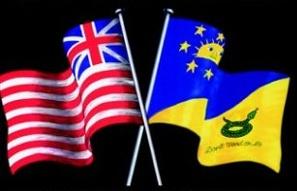When Greenhill Books reprinted Sobel's For Want of a Nail in 1997, whoever did the cover design came up with a very elegant way of representing the book's contents: two cross flagstaffs bearing the flags of the Confederation of North America and the United States of Mexico. The C.N.A. flag is the Continental Colors of 1776 with the British Union Jack in the canton and the thirteen red and white stripes that still appears on the American flag today. The U.S.M. flag has a coiled snake with the words Don't Tread On Me, implying that the ex-rebels who settled in Jefferson adopted the Gadsden flag of the Revolutionary War era, while the circle of stars suggests the Betsy Ross flag.
Although the two national flags were created by a graphic designer at Greenhill Books in the 1990s, and thus were not a "canonical" part of the Sobel Timeline, the members of the For All Nails cabal decided to accept them, thus making them For All Nails Timeline canon. In the course of FAN, both flag designs were changed, with the U.S.M. flag adding two more stars in 1975 with the addition of the states of Jackson and Antillas, and the C.N.A. flag dropping the Union Jack in favor of a white six-pointed star on a dark blue field in 1976 following the Viceroy controversy.
When you think about it, though, neither flag seems likely. When the C.N.A. was established in 1782, the last thing the British would have wanted was to have the new dominion represented by a symbol of the Rebellion, which was what the Continental Colors were. Most likely, the C.N.A. would not have had its own flag; the colonies would have returned to the pre-Rebellion practice of flying the Red Ensign.
With the adoption of the Second Britannic Design in 1842, the resulting upsurge of North American nationalism would have resulted in the adoption of a Confederation flag, but it would not have been the Continental Colors. Most likely, as in the case of Canada in our own history, the C.N.A. flag would have been the Red Ensign with the Coat of Arms of the C.N.A. added. What the C.N.A. Coat of Arms would have looked like is anyone's guess. To give you some idea, here's what the C.N.A. Red Ensign would look like with the 19th century Canadian Arms added. (If any enterprising readers would like to come up with their own versions of the C.N.A. Arms and create their own C.N.A. Red Ensign, go ahead. I'll be pleased to post the results here.)
Sharp-eyed readers will have noticed that the Union Jack in this version of the Red Ensign doesn't include the Cross of St. Patrick. Sobel never mentions the 1801 Act of Union, and opinion in the FAN cabal was that there wouldn't have been one absent the French Revolutionary Wars, so Sobel Timeline Britain keeps the pre-1801 flags.
As for the Mexican flag, that's stepping into deep waters. In the Sobel Timeline, the Mexican War of Independence began after Spain's defeat in the Five Years' War in 1799, though Sobel never says why the Spanish dominions in America rose up. (FAN canon is that the American uprisings were due to the Bourbons being replaced on the Spanish throne by a cadet branch of the Prussian royal family.) In the Sobel Timeline, the Mexican War of Independence was not led by a Mexican, but by a Spaniard: the Count of Revillogigedo, the former Viceroy of New Spain. As for what the Mexican flag would have looked like under his leadership, it might well have incorporated the eagle and snake of our history's Mexican flag, since that bit of iconography was already deeply embedded in Mexican culture at the time of our 1777 point of divergence.
As for the State of Jefferson, they might indeed have adopted the Gadsden flag, but most likely they would have chosen the Stars and Stripes. (If they did use the Gadsden flag, then the symbolism of a Mexican eagle devouring a snake would have been particularly unfortunate.) After the union of Jefferson and Mexico in 1819, Andrew Jackson would have wanted a flag that represented both nations, so perhaps the flag of the U.S.M. wound up with the old Mexican flag in the canton, on a field of 13 red and white stripes:
I'll be the first to admit that my own versions of the C.N.A. and U.S.M. flags aren't as striking as the ones the graphic artist from Greenhill Books came up with, but I do think they're closer to what would have resulted from the history of the Sobel Timeline.
If anyone from my vast global blogging audience happens to disagree, feel free to let me know in the comments.
UPDATE: More Sobel vexillology goodness here.





2 comments:
My own view is that the USM flag depicted on the cover is one of the most poorly-designed flags I have seen in this or any other timeline.
I wonder if the Greenhill graphic designer's thoughts were "OK, I think I remember there's a snake on the Mexican flag and a snake on the Gadsden flag; let's put a snake on there without bothering to look closer."
It strikes me that the CNA flag depicted might be a deeply politically charged artifact in-universe, perhaps associated with the militia movement. Like flying a mutant version of the Stars and Bars.
20 hours ago · Like
Post a Comment